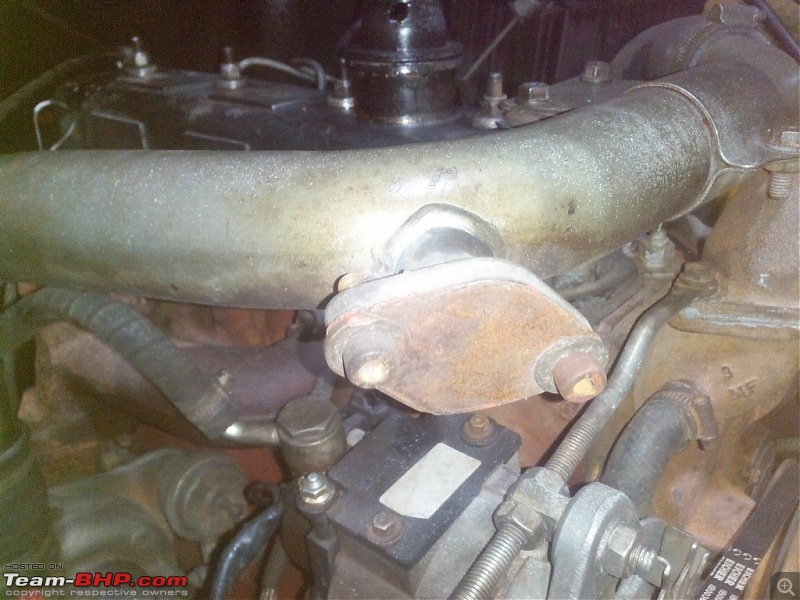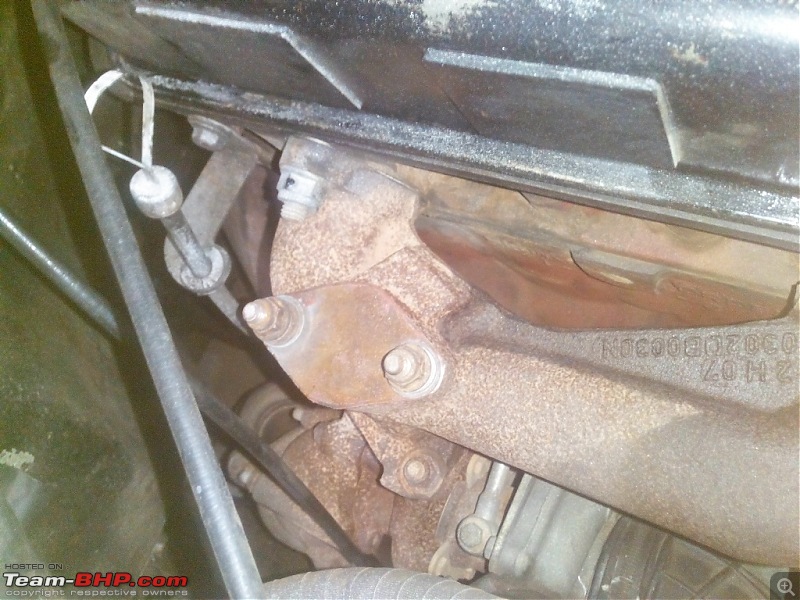Team-BHP
(
https://www.team-bhp.com/forum/)
Quote:
Originally Posted by DirtyDan
(Post 3241185)
If you just disconnect the vacuum tube do you close off the EGR and achieve the same thing?
|
I guess so, by default it would be close and vacuum should open the valve. Again this is a mechanical guess.
EDIT: Sorry or is it the other way around, the experts who designed are here, they should be able to tell.
Quote:
Originally Posted by DirtyDan
(Post 3241185)
If you just disconnect the vacuum tube do you close off the EGR and achieve the same thing?
|
@DirtyDan
Technical right but what if the EGR Valve is faulty and remains partially open always. So to make sure its better to block it.
I went a step further to avoid any doubts of the tin sheet holding under the extreme heat and pressure of exhaust gas. Discarded the whole EGR circuit and lathed 2 solid pieces of metal and blocked the respective ports.


Quote:
Originally Posted by svsantosh
(Post 3247744)
I went a step further to avoid any doubts of the tin sheet holding under the extreme heat and pressure of exhaust gas. Discarded the whole EGR circuit and lathed 2 solid pieces of metal and blocked the respective ports.
|
Did you notice a difference in performance?
I removed the vacuum hose from the EGR. I put a little bolt in the end of the rubbery vacuum hose and taped it in place. This is to keep the vaccum tube doing it's thing, at least temporarily. The idea is that the EGR will then remain closed (I think) with the vaccum removed.
There is a very steep mountain road here that most vehicles have to take in first gear for about 200 meters or so. My DI Invader made it up in second gear quite easily BEFORE I blocked the EGR. But, when I blocked my EGR it went up even easier, the shift points were better. It was like picking up 3-5hp. I am an old hand at testing stuff and have no axe to grind. My conclusion is that you pick up up a little power by blocking off the EGR and even 3-5 HP is a noticeable performance gain on this 63HP engine.
I think 4x4Addict, svsantosh and Timson are right in blocking off the EGR.
You do get a small but noteworthy performance gain. This itself is "Green" for the environment. I wouldn't be surprised if it was "Greener" than the EGR when you take in to consideration the damage to the environment from producing the EGR in the first place. I will bet the myopic bureaucrats never fully studied this trade off.
(The bolt I used to close off the vacuum tube is the same one used as the rich/lean adjuster bolt in the carburetor of the 1933 Packard Roadster, and in the light/dark adjuster in the1961 Sunbeam pop-up toaster... This last was for B.D.)
Quote:
Originally Posted by DirtyDan
(Post 3248010)
Did you notice a difference in performance
|
I honestly dont have baseline data before the EGR block, So cant makeout any difference. From what I understand - in low RPMs, fuel is unburnt 100% and some of it goes back into air intake so some air is dirty at low RPMs. This may contribute to the dip in Bhp and increase in recombustion of the exhaust gases - all hot gas I tell you in the name of green! Not from a elephant weight engine churning out 50-60Hp!!
Yeah, that's my understanding...EGR shunts exhaust gasses back into the engine allowing reburn of exhaust gasses and thereby cleans them....maybe.
E = exhaust
G = gas
R = recycle valve
Santhosh,
Did you change your xd3p engine in armada to Di?Or is it another vehicle?
Quote:
Originally Posted by dracul
(Post 3248203)
Santhosh,
Did you change your xd3p engine in armada to Di?Or is it another vehicle?
|
Another MM540 dracul. Mine is good with the rebuild...
Quote:
Originally Posted by DirtyDan
(Post 3248038)
EGR shunts exhaust gasses back into the engine allowing reburn of exhaust gasses and thereby cleans them
|
EGR is for NOx emission control. And it doesn't circulate all the time, but only at certain conditions.
These emission norms are gelding the modern diesel engines through DPF, cat-con, EGR..
As per what I know, the EGR theory.
# Ideally the EGR should open at high vacuum in inlet manifold.
# That means it opens at the instance when the driver pushes the pedal to metal quickly in order to get more speed.
# In above case where the pedal is connected to the distributor pump, the sudden max pedal means more diesel added/sprayed to combustion chamber, engine tries to pick up suddenly ,tries to draw more air,(thus more vacuum in inlet manifold).
Here it does not always result in proper combustion,(as the amount of diesel sprayed in chamber is more in proportion to the drawn air) hence chances of more un-burnt gasses cum fuel vapors in exhaust.
# The EGR, now actuated by high vacuum, re introduces the unburnt fumes in the inlet, this seems to be done to save the release of unburnt gasses in the atmosphere & also save fuel.
# The EGR according to me, is also meant to open at max RPM ,where sometimes the chances of total burning of fuel are lesser (in such cases one can see diesel vehicles smoking black due to improper combustion)
Secondly according to some people, the pre conditioning of inlet gasses is necessary for proper combustion, EGR by way of sending the unburnt fuel vapors to the engine actually helps save fuel & helps efficient combustion.
All above is theory, but in practice the function of the EGR does not happen according to it . Some times it gets stuck/jammed open ,it leaks & thus damaging the fresh air supply to engine when not required. Means it actually feeds "Burnt" gasses to engine in place of unburnt fumes thus reducing efficiency.
I think in older vehicles where the function of the EGR is not proper it either needs to be repalced or blocked/removed.
sudarshan
Quote:
Originally Posted by svsantosh
(Post 3247744)
I went a step further to avoid any doubts of the tin sheet holding under the extreme heat and pressure of exhaust gas.
|
When you removed the blocking tin sheet(for welding the pipe shut), how was it's condition?
And yes, if it did not withstand the heat/pressure, the consequences are unimaginable!
Quote:
Originally Posted by ramzsys
(Post 3248622)
When you removed the blocking tin sheet(for welding the pipe shut), how was it's condition?
And yes, if it did not withstand the heat/pressure, the consequences are unimaginable!
|
Between the 2 mods the Jeep didnt cross 10-12 Kms, was in between garage and AC shop -- work was going on - so not much change in the tin sheet.
I too had the same thinking, if the tin melts or disintegrates for some reason, it would land up inside the head.
Unimaginable - nope, its very clear what would happen if a foreign object (metal) were to enter a intake manifold. In simple terms it would need a head rebuild. When the head is out, check for sleeve damage due to broken valves/guides. And the standard procedure for a top end or a bottom end rebuild...
EGR apart from the known reasons, some of them mentioned above , is also used for thermal dethrottling. Efficiency improves with this.
Spike
Quote:
Originally Posted by SPIKE ARRESTOR
(Post 3250658)
EGR apart from the known reasons, some of them mentioned above , is also used for thermal dethrottling. Efficiency improves with this.
Spike
|
What is thermal de throttling and why or how does it improve efficiency? Could you please explain, never heard of it before.
Thanks
Jeroen
Interestingly, the new Thar DIs come with an EGR ECU. (not sure when this was introduced though!) So I suppose, in the new models, one will not have a need to block, the ECU will be handling better than the non ECU method.
| All times are GMT +5.5. The time now is 07:25. | |



